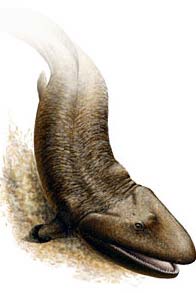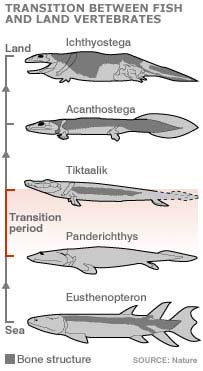 |
|
Scientists believe that this creature lived in shallow waters. (Image: BBC) |
Fossils of animals discovered in the Arctic region of Canada have provided preliminary insights into the evolution of fish species as they transitioned to land-dwelling animals.
Published in Nature, American paleontologists have detailed fossils described as “long-lost links.” These 383-million-year-old specimens resemble crocodile-like creatures, featuring fins instead of legs, and were likely adapted to shallow waters.
 |
|
The nearly intact fossil of the new creature. (Image: BBC) |
 |
|
The transition from fish to land vertebrates. (Image: BBC) |
Prior to this discovery, it was known that lobe-finned fish evolved into land-dwelling creatures during the Devonian period. However, based on fossil evidence, there remained a gap between Panderichthys—a fish that lived around 385 million years ago, displaying the earliest features adapted for life on land—and Acanthostega, the earliest known tetrapod (land-dwelling animals that moved on four limbs) which dates back approximately 365 million years.
In 1999, paleontologist Professor Neil Shubin from the University of Chicago and Edward Daeschler from the Academy of Natural Sciences in Philadelphia began exploring the Arctic region of Canada in an effort to find this “missing link” and explain the transition of creatures from water to land.
After several years of searching with little success, they achieved a breakthrough in 2004.
The team discovered three nearly intact fossils of a new species, Tiktaalik roseae, in an area of the Arctic known as Nunavut Territory. The largest specimen measured about 3 meters in length.
These creatures exhibited several fish-like characteristics: they had fins and scales on their backs, but also shared many features with terrestrial animals. They possessed a crocodile-like head with eyes positioned on top and a primitive neck—a feature not found in fish.
“When examining the fin, we observed the presence of a shoulder, elbow, and a primitive wrist, elements very similar to those found in all land-dwelling animals,” Professor Shubin noted. “Essentially, we had a species whose body structure supported life on land,” he explained.
Scientists also believe that the positioning of the eyes suggests they might have lived in shallow waters.
“We found a very significant transition at a crucial point in time. Its significance lies in the fact that this is a fossil that blurs the boundaries between two forms of life—between an aquatic creature and one that lives on land.”
T. An


















































